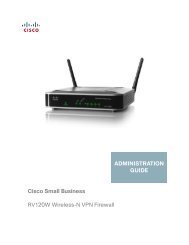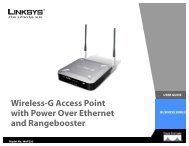Cisco Catalyst 6500 Supervisor 2T Architecture - Ipland
Cisco Catalyst 6500 Supervisor 2T Architecture - Ipland
Cisco Catalyst 6500 Supervisor 2T Architecture - Ipland
Create successful ePaper yourself
Turn your PDF publications into a flip-book with our unique Google optimized e-Paper software.
White PaperLayer 3 - IPv6 TunnellingThe PFC3x did not support IPv6 tunnelling options where the outer header was an IPv6 header. This behavior haschanged with PFC4. The PFC4 now supports the following new IPv6 tunnelling options:● ISATAP (Intra-Site Automatic Tunnel Address Protocol): ISATAP tunnelling protocol allows IPv6 packetsto be globally routed through the IPv6 network, while also being automatically tunneled through IPv4 cloudslocally within a site. ISATAP tunnelling uses an address format with specially constructed 64-bit EUI-64interfaces ID. PFC4 fully supports ISATAP tunnels, whereas PFC3x offered only partial support.● IPv6 tunnel for GRE packets: PFC4 supports IPv6 GRE tunnelling mode, where both IPv4 and IPv6 packetscan be encapsulated in an IPv6 GRE header and tunnelled across an IPv6 network. The PFC3x had limitedsupport for this tunnelling mode. The PFC4 can support up to 256 IPv6 GRE tunnels.● IPv6 generic tunnelling: IPv6 packets can be encapsulated in an IPv6 or IPv4 header and tunnelled acrossthe IPv6 network. The PFC4 offers support for this mode and 256 tunnel source addresses are supported.The PFC3x family did not support this tunnelling option.Layer 3 - VPLSVirtual Private LAN Service (VPLS) allows for a Layer 3 MPLS network to appear to operate like a Layer 2 Ethernetbasednetwork. It effectively allows native Ethernet frames to be transported across an MPLS network providing anyto any connectivity, just as if it were on a normal Ethernet LAN. Previous PFC engines required an external WANcard, such as the OSM or SIP-400, to provide support for VPLS. With PFC4, VPLS is supported natively, and noexternal WAN cards are required for this support.Layer 3 - MPLS over GREThe PFC4 now supports the MPLS over GRE tunnelling option in hardware. This was not supported in previousPFC3x engines. This capability is important for those customers looking to join MPLS backbones over a common IPnetwork.Layer 3 - MPLS Tunnel ModesMPLS provides a number of options for controlling how the EXP (experimental bit) can be set. The EXP valueprovides a way for a priority value to be assigned to an MPLS packet. The EXP setting is three bits providing 23values (eight values). The mechanisms used to control the setting of the EXP bit are referred to as tunnel modes,and are defined in RFC3270. The three tunnel modes are called uniform, short pipe, and pipe tunnel modes.In uniform mode, any changes made to the EXP value of the topmost label on a label stack are propagated bothupward, as new labels are added, and downward, as labels are removed.In short pipe mode, the IP precedence bits in an IP packet are propagated upward into the label stack as labels areadded. When labels are swapped, the existing EXP value is kept. If the topmost EXP value is changed, this changeis propagated downward only within the label stack, not to the IP packet.Full pipe mode is just like short pipe mode, except the PHB (per-hop behavior) on the mpls2ip link is selected, basedon the removed EXP value rather than the recently exposed type of service value. The underlying type of service inthe IP header in the packet is not modified.Regarding current levels of support for MPLS tunnel modes, previous PFC3x forwarding engines supported shortpipe and uniform tunnel modes. The PFC4 now adds support for full pipe tunnel mode.Layer 3 - Increased Support for Ethernet over MPLS TunnelsEthernet over MPLS (EoMPLS) provides a mechanism for two disparate LAN networks to be joined over an MPLSnetwork, thus allowing Ethernet frames to traverse an MPLS cloud. The PFC3x supported a maximum of 4 K© 2011-2012 <strong>Cisco</strong> and/or its affiliates. All rights reserved. This document is <strong>Cisco</strong> Partner Confidential Information. Page 20 of 46
















